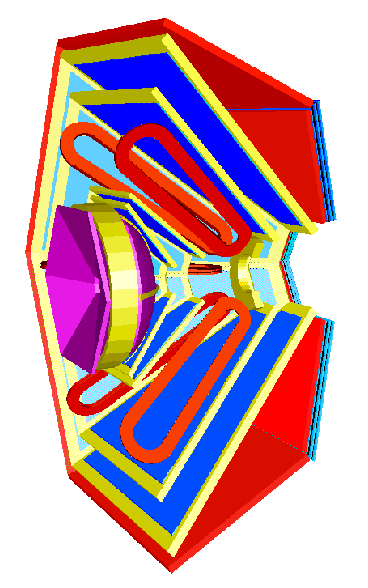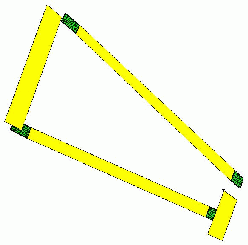 |
HADES @ FZ Rossendorf |  |
 |
HADES @ FZ Rossendorf |  |
What is HADES ?
 The
High
Acceptance
Di-Electron
Spectrometer
HADES
is a high resolution experiment for lepton pair spectroscopy, currently
setup at the Heavy Ion Synchrotron SIS at GSI
(Gesellschaft für Schwerionenforschung) by a European collaboration involving groups from 21 universities and institutions in 9 countries.
The
High
Acceptance
Di-Electron
Spectrometer
HADES
is a high resolution experiment for lepton pair spectroscopy, currently
setup at the Heavy Ion Synchrotron SIS at GSI
(Gesellschaft für Schwerionenforschung) by a European collaboration involving groups from 21 universities and institutions in 9 countries.
The HADES detector is specifically
designed to provide excellent mass resolution (dm/m
1 % ) and a very large acceptance for comprehensive studies of the behavior
of
r, w and f-
mesons in the nuclear medium. These mesons are produced in nucleus nucleus
(AA), proton nucleus (pA) and pion
nucleus (pA) collisions at a few GeV/nucleon.
They may partially decay within the nuclear fireball. Because of their
weak final state interaction dilepton decay channels are suitable probes
to study medium effects on these mesons, such as effective masses, decay
widths etc. Also their fundamental electromagnetic properties are accessible.
First experiments are scheduled for 1999.
HADES @ FZ Rossendorf, Institute for Nuclear and Hadron Physics
In 1998 we participated in preparing the first physics proposal for HADES for the years 1999/2000. Initial studies using pp elastic scattering will be followed by electron pair detection in pp, pA and AA collisions. The emphasis will be on the low invariant mass region (100 MeV/c2 < Mee < 500 MeV/c2) where background contributions by h and D Dalitz decays have to be understood in detail.
The FZ Rossendorf, Institute for Nuclear and Hadron Physics, delivers one of the two large planes of driftchambers to the HADES experiments. Over the last two years we have fixed the physical and technical aspects of their design and production. The large scale production of these chambers has started in March 1999 and the full set of six trapezoidally shaped driftchambers will be finished by early 2000.
The HADES tracking system consists of four drift chambers (I-IV), two before and two behind the toroidal magnetic field produced by 6 superconducting coils. Each drift chamber is composed of six trapezoidal modules and has the form of a frustrum. A module covers 60 degrees of azimuthal angle and 4 modules of the detectors I to IV each form a sector. Module sizes range from 88 cm x 80 cm to 280 cm x 230 cm (height times larger baseline).
A chamber module is composed out of six drift cell layers. The cell sizes vary from 5x5 mm2 to 14x10 mm2 from detector I to IV to achieve a constant granularity. The cells are formed by interspersed sense and field wires and cathode wire planes. The total number of drift cells is 27.000.
HADES Driftchambers: MDC III

At the detector laboratory of the FZ Rossendorf the final design of
the large trapezoidal low-mass drift chambers of the HADES tracking system
has been developed. Being second largest tracking plane (MDC III) of the
spectrometer it consists of 6 modules with an active area of roughly 2.2x2m2,
drift cell size 8x12 mm2. Each module has
6 drift cell layers, i.e.\ 6 anode and 7 cathode frames. Due to the enormous
size of the frames (see left) they have to be assembled from four pieces(see
right) which have to be glued together at each of the edges of the trapezoidally
shaped frame. The frames consist of Stesalit material (Stesalit EP107-G118-40,
Y=30 GPa). For the machining and glueing of the frames a small company
(Kossmann, 78532 Tuttlingen, Germany) was chosen which had already proven
to be well equipped for manufacturing another of the HADES tracking planes
(MDC I) for the detector laboratory of GSI/Darmstadt. Bare Al-wires (80
and 100
mm diameter) for cathode and field wires
and gold plated tungsten wires (20
mm diam.)
have been ordered.  Readout
pads (T-shaped, so called "Segelflieger") for the wires have been developed.
The mass production has started in March 1999 and the full set of six trapezoidally
shaped driftchambers will be finished by early 2000.
Readout
pads (T-shaped, so called "Segelflieger") for the wires have been developed.
The mass production has started in March 1999 and the full set of six trapezoidally
shaped driftchambers will be finished by early 2000.
A wealth of information on the HADES driftchambers can be found on the
HADES-MDC
homepage maintained by the Univ Frankfurt, where the entire MDC project is coordinated.
See the notes
in the documentation pool.
E.g. particularly helpful for orientation purposes are notes 3/98
(MDC reference system) and 4/98
(number of readout channels). The MDC project is a common effort of four
different institutions:
| GSI Darmstadt, Germany | MDC I |
| JINR/LHE Dubna, Russia | MDC II |
| FZ Rossendorf, Germany | MDC III |
| IPN Orsay, France | MDC IV |
People working on the HADES experiment at FZ Rossendorf
The following people from the Hadron Physics Department of the Institute for Nuclear and Hadron Physics contribute to the HADES experiment at FZ Rossendorf:
Dr F Dohrmann
From the detector laboratory, belonging to the Radiation
Physics Department of the Institute
for Nuclear and Hadron Physics, the following people contribute to
the HADES experiment
Dr W Enghardt
Dr R Dressler
Prof E Grosse
Dr L Naumann
R Förster
L Heinrich
K Heidel
J Hutsch
M Paul
J Schwarzenau
M. Sobiella
|
|
 |
|
IKH last change 02 August 1999 © F. Dohrmann